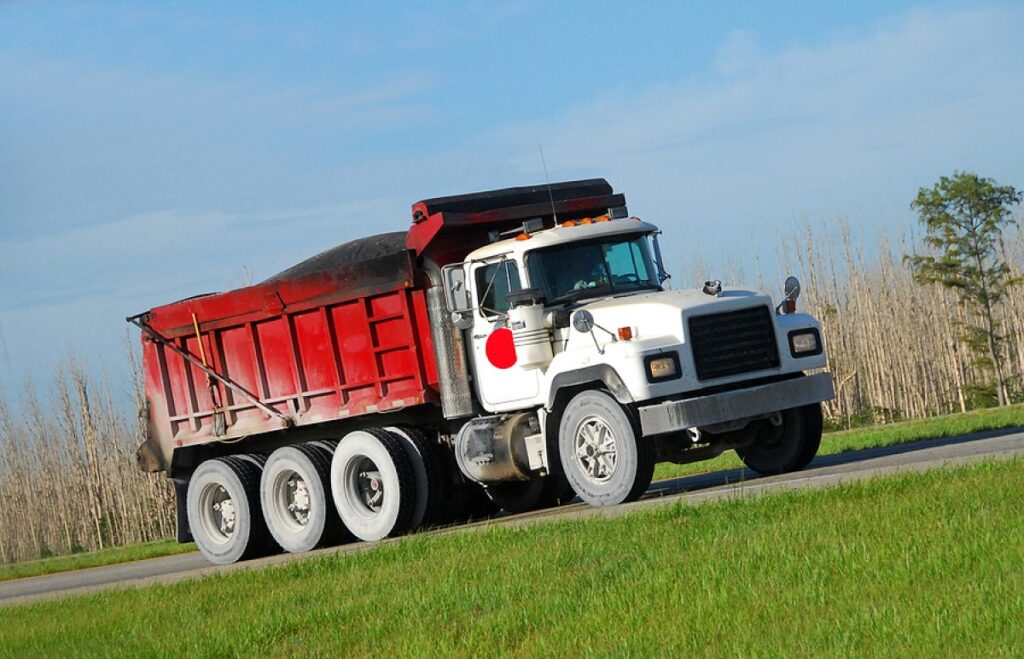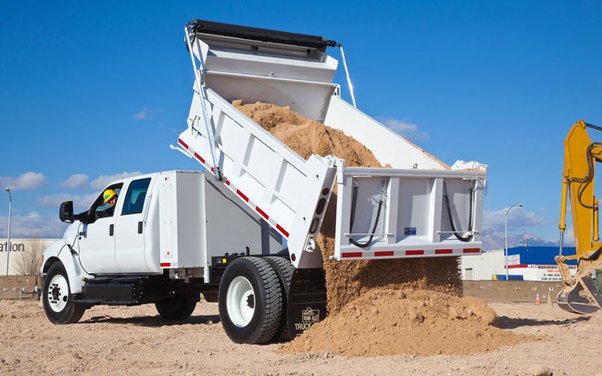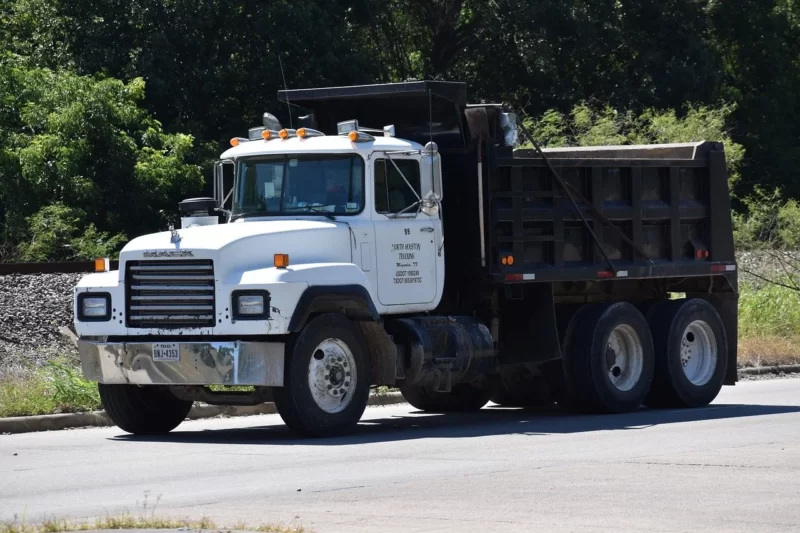There are many types of loose material sold in cubic yards or simply “yards.” Topsoil, mulch, and gravel are just a few of the common products sold by this volume metric. Knowing the cubic yardage of a dump truck is vital information for any construction project. Generally speaking, most dump trucks have a capacity of between 10 and 16 cubic yards. However, some smaller dump trucks can only hold 1.5 cubic yards. In the following guide, we will discuss how to determine the cubic yard capacity of a dump truck.
What Are Cubic Yards?
Before we get into the details of how many cubic yards, let’s take a step back and make sure we know the cubic yards in the first place.
The cubic yard is the standard unit of measure for determining the number of certain building materials. It refers to the amount of material required to fill the net volume of a 1-yard cube. In other words, if you have an area that is 1 yard high, wide, and long and you can fill it with some material, then you get a cubic yard.
Having a feeling for cubic yards is very important because it can help you understand how much you have to pay for a certain construction project. If you can’t sell much in cubic yards, converting it to feet might help a little. There are 27 cubic feet per cubic yard.
How Many Cubic Yards In a Dump Truck?

Yard capacity varies by tipper model, size, and type. Capacity depends primarily on cubic yards and weight rating. It also depends on the suspension, structure, and chassis. The cubic yard capacity of different dump trucks is discussed below:
1. Full-Size Dump Trucks: These are the most commonly used dump trucks as landscape architects and contractors use them frequently. Their capacities range from 12 to 16 cubic yards. Almost any type of material can be transported with these trucks.
2. Semi-dump truck: This type of truck is increasingly popular. Its capacity is 8-14 cubic yards.
3. Standard Dump Trucks: These trucks carry 6 cubic yards to 12 cubic yards. Earthworks are usually transported inside these dump trucks.
4. Small dump trucks: These types of trucks do have a smaller capacity. They are usually used for smaller projects and specific purposes. They have a capacity of 1-1.5 cubic yards.
5. Three-axle dump truck: Its range is usually 3 to 10 cubic yards. Although in the US, most of them average 7-8 cubic yards. It should be noted that many states in the US only allow it up to 6 cubic yards.
6. Double-chamber dump truck: The capacity range of the double-chamber dump truck is 12-16 yards. It basically depends on their size. If they have a good weight, they can easily go 12+ yards.
See more about How To Start A Dump Truck Business?
How To Measure How Many Cubic Yards Of Material Do I Need?
If you’re managing a construction project, you need to learn how to measure how many cubic yards you need. This way, you can determine the total amount of cubic yards required, and thus the number of trips the tipper will need to complete the transport of project materials.
Keep in mind that there are plenty of online tools available that can easily and quickly calculate how many cubic yards an area needs. However, learning the basics can help you feel the numbers and help you control the results you get from these calculators.
In general, here’s how to calculate how much material is needed for an area:
- Determine the total area of the project. You can do this by calculating the width and length of the feet.
- Calculate the total number of intentional material deaths you plan.
- Perform a quick head conversion from feet to inches by multiplying by 12 to convert.
- Calculate volume by multiplying depth by total area.
- Divide the final number by 46656 to convert cubic feet to cubic yards.
Remember that this simple method only works for rectangular or square areas. However, if the shape of the project area is different, you may need to rely on some available online tools to calculate the cubic yard material required for the project, depending on the shape of the area.
Process of Determining Cubic Yards in a Dump Truck

The easiest way to find out about capacity is to look at the owner’s manual. You will get detailed information about the truck in the owner’s manual. However, if you are still unable to understand the capacity of your truck, follow these simple steps to understand capacity of your dump truck:
1. Length measurement:
We need to measure the length of the truck bed first. To do this, measure the length of the inner wall from one side to the other. Make sure to measure in feet, this will help with calculations later. So, if you measure it in inches or meters, convert it to feet.
2. Width measurement:
Next, it’s the width’s turn. Measure the width in a similar way. Don’t forget to replace it with feet. For example, if your truck bed has a width range of 72 inches, convert that to feet (6 feet) and make a note.
3. Height measurement:
In height measurement, you have to measure from the top to the bottom of the side. Remember, if the tailgate is lower than the side, you must measure the height from there.
4. Multiplication:
Now you have measured length, width, and height. Time to multiply them. Again, make sure you’ve converted all of them to feet. So if the truck bed is 6 feet wide, 4 feet high, and 15 feet long, the calculation would be 6 x 4 x 15 = 360. Note that this is an amount in cubic feet.
5. Divide by 27:
You already know that there are 27 cubic feet in a cubic yard. So to calculate cubic yards, you need to divide the amount in cubic feet by 27. So if the quantity in cubic feet is 360, divide it by 27 and you will know the number of cubic yards in your dump truck (360/27=13.33).
So by following these simple steps, you can easily measure cubic yards. You can also get help from different calculators. But, again, our advice is to take a look at the owner’s manual to get a clear idea of the truck’s capacity.
How To Choose The Right Dump Truck?
If you plan to transport a lot of materials and your job requires transporting those materials from one location to another, it may be worthwhile to buy a dump truck. Unfortunately, it’s full of too many
Here are some factors to keep in mind when choosing your next dump truck:
- body style
Different body styles include simulated oval, with the ground and traditional rectangular, shopping and without dump truck. Therefore, you have to look at each one to see which one suits your needs better.
- body material
The body material itself is different from the old dump truck. Yes, they are all made of metal, but each medal is different and has its own tensile and strength capabilities. Generally, most dump trucks are made of aluminum or steel.
- engine power
Custom trucks have different powers ranging from 300 to 600 horsepower. Determining the correct power is critical as it can significantly affect the final price. Auto experts recommend that you don’t buy more power than you need, as it’s seen as a waste of money if you don’t use it.
- Transmission capacity
While most small vehicles come with automatic transmissions, dump trucks offer manual transmissions that allow you to maneuver more easily and nimbly. So, before you decide to buy your next dump truck, check the type of transmission you want to use based on your specific job.
- Dump Axle Requirements
The tipper axle requirements specify exactly the rated weight and the weight that the tipper can transport. Of course, the actual requirements are specified along with the engine, body, and suspension system. So keep that in mind and look at the gross vehicle weight rating or GVWR specification.
Summary
Dump trucks are one of the most important vehicles for any construction project. Knowing how many cubic yards are in a dump truck is critical to maintaining a budget and preventing surprises during construction.
In general, most dump trucks have loads between 10 and 15 cubic yards. However, smaller trucks may hold no more than 1.5 cubic yards.
